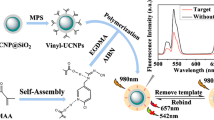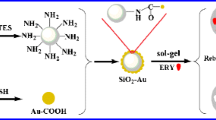Abstract
The paper describes the preparation of a fluorescent probe based on the use of up-conversion particles (UCPs) of the type NaYF4: Er, Yb and shelled with a molecularly imprinted polymer (MIP) that is specific for the antibiotic enrofloxacin. The upconverted green luminescence emitted by the UCPs upon photoexcitation at 980 nm was used to locally generate a thin MIP shell around the UCPs via photopolymerization. Enrofloxacin is used as the template, and ethylene glycol dimethacrylate (EGDMA) as the cross-linking agent. It is found that enrofloxacin is well captured by the MIP and then quenches the fluorescence of the UCPs. Fluorescence decreases linearly in the 63 ng·L−1 to 60 μg·L−1 enrofloxacin concentration range, with a 8 ng·L−1 limit of detection. The method was applied to the determination of enrofloxacin in spiked fish samples. Recoveries ranged from 83.7 to 87.7%, with relative standard deviations between 2.0 and 5.5% (for n = 3).

Schematic of an NIR-responsive up-conversion nanoparticle probe of the NaYF4:Er,Yb type and coated with a MIP for fluorometric determination of enrofloxacin. The upconverted luminescence emitted by the UCPs was used to locally generate a thin MIP shell around the UCPs via photopolymerization.




Similar content being viewed by others
References
Tang Y, Li M, Gao X, Liu X, Ma Y, Li Y, Xu Y, Li J (2016) Preconcentration of the antibiotic enrofloxacin using a hollow molecularly imprinted polymer, and its quantitation by HPLC. Microchim Acta 183(2):589–596
Yu F, Yu SC, Yu LL, Li YQ, Wu YJ, Zhang HQ, Qu LB, Harrington PD (2014) Determination of residual enrofloxacin in food samples by a sensitive method of chemiluminescence enzyme immunoassay. Food Chem 149:71–75
Aral F, Karacal F, Baba F (2008) The effect of enrofloxacin on sperm quality in male mice. Res Vet Sci 84(1):95–99
Lim S, Hossain MA, Park J, Choi SH, Kim G (2008) The effects of enrofloxacin on canine tendon cells and chondrocytes proliferation in vitro. Vet Res Commun 32(3):243–253
Wang ZH, Zhang HY, Ni HJ, Zhang SX, Shen JZ (2014) Development of a highly sensitive and specific immunoassay for enrofloxacin based on heterologous coating haptens. Anal Chim Acta 820:152–158
Haag G, Marin GH, Errecalde J (2016) Quantification of residual enrofloxacin and ciprofloxacin in feathers of broiler chickens by high-performance liquid chromatography-fluorescence after oral administration of the drugs. J Adv Pharm Technol 7(1):2–5
Lombardo-Agui M, Garcia-Campana AM, Cruces-Blanco C, Gamiz-Gracia L (2015) Determination of quinolones in fish by ultra-high performance liquid chromatography with fluorescence detection using QuEChERS as sample treatment. Food Control 50:864–868
Annunziata L, Visciano P, Stramenga A, Colagrande MN, Campana G, Scortichini G, Migliorati G, Compagnone D (2016) Development and validation of a method for the determination of quinolones in muscle and eggs by liquid chromatography-tandem mass spectrometry. Food Anal Methods 9(8):2308–2320
Cortejade A, Kiss A, Cren C, Vulliet E, Bulete A (2016) Development of an analytical method for the targeted screening and multi-residue quantification of environmental contaminants in urine by liquid chromatography coupled to high resolution mass spectrometry for evaluation of human exposures. Talanta 146:694–706
Xu X, Liu L, Jia Z, Shu Y (2015) Determination of enrofloxacin and ciprofloxacin in foods of animal origin by capillary electrophoresis with field amplified sample stacking-sweeping technique. Food Chem 176:219–225
Wang H, Liu Y, Wei S, Yao S, Zhang J, Huang H (2016) Selective extraction and determination of fluoroquinolones in bovine milk samples with montmorillonite magnetic molecularly imprinted polymers and capillary electrophoresis. Anal Bioanal Chem 408(2):589–598
Zhao Y, Zhang G, Liu Q, Teng M, Yang J, Wang J (2008) Development of a lateral flow colloidal gold immunoassay strip for the rapid detection of enrofloxacin residues. J Agric Food Chem 56(24):12138–12142
Yu F, Wu Y, Yu S, Zhang H, Zhang H, Qu L, Harrington Pde BA (2012) Competitive chemiluminescence enzyme immunoassay for rapid and sensitive determination of enrofloxacin. Spectrochim Acta A Mol Biomol Spectrosc 93:164–168
Wu Y, Guo S, Dong Q, Song Y (2016) Development of an immunochromatographic test stripfor rapid simultaneous detection of enrofloxacinand ofloxacin in tissue of chicken muscle and pork. Food Anal Methods 9:2807–2813
Wei JF, Ren J, Liu J, Meng XW, Ren XL, Chen ZZ, Tang FQ (2014) An eco-friendly, simple, and sensitive fluorescence biosensor for the detection of choline and acetylcholine based on C-dots and the Fenton reaction. Biosens Bioelectron 52:304–309
Shi JY, Chan CY, Pang YT, Ye WW, Tian F, Lyu J, Zhang Y, Yang M (2015) A fluorescence resonance energy transfer (FRET) biosensor based on graphene quantum dots (GQDs) and gold nanoparticles (AuNPs) for the detection of mecA gene sequence of Staphylococcus aureus. Biosens Bioelectron 67:595–600
Liu X, Ren J, Su L, Gao X, Tang Y, Ma T, Zhu L, Li J (2017) Novel hybrid probe based on double recognition of aptamer-molecularly imprinted polymer grafted on upconversion nanoparticles for enrofloxacin sensing. Biosens Bioelectron 87:203–208
Wang M, Zhu Y, Mao CB (2015) Synthesis of NIR-responsive NaYF4:Yb,Er upconversion fluorescent nanoparticles using an optimized solvothermal method and their applications in enhanced development of latent fingerprints on various smooth substrates. Langmuir 31(25):7084–7090
Yang Y (2014) Upconversion nanophosphors for use in bioimaging, therapy, drug delivery and bioassays. Microchim Acta 181(3–4):263–294
Wang M, Hou W, Mi CC, Wang WX, Xu ZR, Teng HH, Mao CB, Xu SK (2009) Immunoassay of goat antihuman immunoglobulin G antibody based on luminescence resonance energy transfer between near-infrared responsive NaYF4:Yb, Er upconversion fluorescent nanoparticles and gold nanoparticles. Anal Chem 81(21):8783–8789
Chen GY, Qju HL, Prasad PN, Chen XY (2014) Upconversion nanoparticles: design, nanochemistry, and applications in theranostics. Chem Rev 114(10):5161–5214
Tsang MK, Chan CF, Wong KL, Hao JH (2015) Comparative studies of upconversion luminescence characteristics and cell bioimaging based on one-step synthesized upconversion nanoparticles capped with different functional groups. J Lumin 157:172–178
Wu YM, Cen Y, Huang LJ, Yu RQ, Chu X (2014) Upconversion fluorescence resonance energy transfer biosensor for sensitive detection of human immunodeficiency virus antibodies in human serum. Chem Commun 50(36):4759–4762
Zhao P, Wu YY, Zhu YH, Yang XL, Jiang X, Xiao JF, Zhang YX, Li CZ (2014) Upconversion fluorescent strip sensor for rapid determination of vibrio anguillarum. Nano 6(7):3804–3809
Hlavacek A, Farka Z, Hubner M, Hornakova V, Nemecek D, Niessner R, Skladal P, Knopp D, Gorris HH (2016) Competitive upconversion-linked immunosorbent assay for the sensitive detection of diclofenac. Anal Chem 88(11):6011–6017
Wu S, Duan N, Wang Z, Wang H (2011) Aptamer-functionalized magnetic nanoparticle-based bioassay for the detection of ochratoxin a using upconversion nanoparticles as labels. Analyst 136(11):2306–2314
Chen H, Yuan F, Wang S, Xu J, Zhang Y, Wang L (2013) Aptamer-based sensing for thrombin in red region via fluorescence resonant energy transfer between NaYF(4):Yb,Er upconversion nanoparticles and gold nanorods. Biosens Bioelectron 48:19–25
Weng X, Neethirajan S (2016) A microfluidic biosensor using graphene oxide and aptamer-functionalized quantum dots for peanut allergen detection. Biosens Bioelectron 85:649–656
Ye L, Haupt K (2004) Molecularly imprinted polymers as antibody and receptor mimics for assays, sensors and drug discovery. Anal Bioanal Chem 378(8):1887–1897
Hu YX, Feng SL, Gao F, Li-Chan ECY, Grant E, Lu XN (2015) Detection of melamine in milk using molecularly imprinted polymers-surface enhanced Raman spectroscopy. Food Chem 176:123–129
Guo T, Deng Q, Fang G, Gu D, Yang Y, Wang S (2016) Upconversion fluorescence metal-organic frameworks thermo-sensitive imprinted polymer for enrichment and sensing protein. Biosens Bioelectron 79:341–346
Tian J, Bai J, Peng Y, Qie Z, Zhao Y, Ning B, Xiao D, Gao Z (2015) A core-shell-structured molecularly imprinted polymer on upconverting nanoparticles for selective and sensitive fluorescence sensing of sulfamethazine. Analyst 140(15):5301–5307
Li Z, Zhang Y (2008) An efficient and user-friendly method for the synthesis of hexagonal-phase NaYF4: Yb, Er/tm nanocrystals with controllable shape and upconversion fluorescence. Nanotechnology 19(34):345606
Zhao GJ, Liu JY, Zhou LC, Han KL (2007) Site-selective photoinduced electron transfer from alcoholic solvents to the chromophore facilitated by hydrogen bonding: a new fluorescence quenching mechanism. J Phys Chem B 111:8940–8945
Wang HF, He Y, Ji TR, Yan XP (2009) Surface molecular imprinting on Mn-doped ZnS quantum dots for room-temperature phosphorescence optosensing of pentachlorophenol in water. Anal Chem 81:1615–1621
Acknowledgments
This work was financially supported by the National Natural Science of China (Grant No. 31201370) and the Graduate Innovation Foundation of Bohai University (071502224-49).
Author information
Authors and Affiliations
Corresponding authors
Ethics declarations
The author(s) declare that they have no competing interests.
Electronic supplementary material
ESM 1
(DOC 12403 kb)
Rights and permissions
About this article
Cite this article
Tang, Y., Li, M., Gao, X. et al. A NIR-responsive up-conversion nanoparticle probe of the NaYF4:Er,Yb type and coated with a molecularly imprinted polymer for fluorometric determination of enrofloxacin. Microchim Acta 184, 3469–3475 (2017). https://doi.org/10.1007/s00604-017-2387-9
Received:
Accepted:
Published:
Issue Date:
DOI: https://doi.org/10.1007/s00604-017-2387-9




